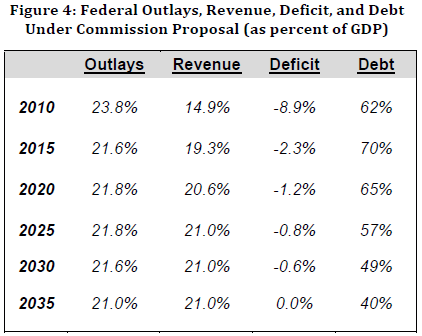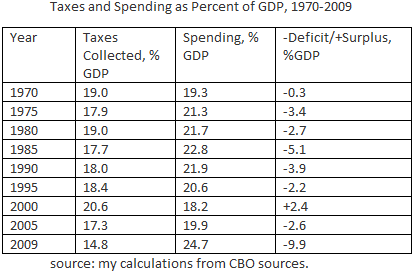President Obama is expected to lay out a vision today for his preferred next steps to achieve a long term balanced budget. Many believe that he will endorse or embrace at least some aspects of the Fiscal Commission final recommendations. Yesterday, I outlined the health policy aspects of the Commission report that provide additional policies beyond those enacted by the Affordable Care Act to address health care costs. Addressing health care costs is a necessary, but not a sufficient condition to ever having a balanced budget. At the 50,000 foot level, the Fiscal Commission charts a path to a balanced budget in 2035 with taxes and spending at 21% of GDP (Table 4 from the Commission Report, p. 16).
 Seeking balance at 21% of GDP around 25 years from now means that spending will have to decrease over current levels (and particularly as compared to auto-pilot health care cost inflation levels) and taxes will have to rise. The table below that I put together from CBO sources provides some historical context about the goal of balancing taxes and spending at 21% of GDP.
Seeking balance at 21% of GDP around 25 years from now means that spending will have to decrease over current levels (and particularly as compared to auto-pilot health care cost inflation levels) and taxes will have to rise. The table below that I put together from CBO sources provides some historical context about the goal of balancing taxes and spending at 21% of GDP.
 At 21% of GDP, taxes would be the highest amount since I have been alive (max 20.6% in 2000). However, spending was higher than 21% of GDP in 1975, 1980, 1985 and 1990, and the baby boomers were working and paying payroll taxes in those years, not collecting Social Security and Medicare. Of course, this is merely another way of restating the fact that we have had a balanced budget in only 4 of the 43 years that I have been alive. While it is mathematically possible to balance the budget at a lower percentage of GDP, it seems non-controversial to me that it will take something like the 21% of GDP target specified by the Fiscal Commission to achieve a balanced budget given the demographic and health care realities of our nation.
At 21% of GDP, taxes would be the highest amount since I have been alive (max 20.6% in 2000). However, spending was higher than 21% of GDP in 1975, 1980, 1985 and 1990, and the baby boomers were working and paying payroll taxes in those years, not collecting Social Security and Medicare. Of course, this is merely another way of restating the fact that we have had a balanced budget in only 4 of the 43 years that I have been alive. While it is mathematically possible to balance the budget at a lower percentage of GDP, it seems non-controversial to me that it will take something like the 21% of GDP target specified by the Fiscal Commission to achieve a balanced budget given the demographic and health care realities of our nation.

